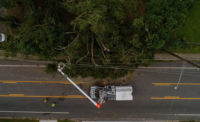Major elements of the new storm defenses encircling New Orleans saw action for the first time in storm conditions on Aug. 29 as the battle to shield the city from Hurricane Isaac's floods and storm surge ground on through the day and into the night.
In a statement on its website, the New Orleans District of the U.S. Army Corps of Engineers says the Hurricane and Storm Damage Risk Reduction System is performing as designed during what is turning into an extended load test. The newly completed, $14.45-billion system was built in the aftermath Hurricane Katrina — which savaged the area seven years ago to the day — to reduce the risk from just such storms.
The HSDRRS sprawls five parishes and consists of 350 miles of levees and floodwalls, 73 non-federal pumping stations, 3 canal closure structures with pumps and four gated outlets.
In statement issued at 5 p.m. local time, the National Weather Service reported that Isaac continues to drag very slowly toward the northwest, but is developing heavy bands of thunderstorms with strong winds and gusts exceeding 60 kt in the quadrants of the storm still hanging over the waters of the Gulf of Mexico. The storm is then whipping the bands of high winds and heavy rain ashore to spread across coastal areas of southern Louisiana and Mississippi, including New Orleans.
In a statement issued by the Federal Emergency Management Agency, Craig Fugate, FEMA administrator, warns that “as the storm continues to move inland, there are a number of areas both along the coast and inland that can be affected by strong winds, storm surge and inland flooding and tornadoes."
FEMA says power outages have been reported throughout Alabama, Florida, Louisiana and Mississippi. As many as 600,000 customers are reportedly without electricity across the region.
FEMA also reports that the Corps of Engineers has proactively deployed emergency power teams to Alabama, Louisiana and Mississippi to supply the energy needs of critical infrastructure and facilities.
Also, USACE has deployed commodities, debris, and temporary roofing teams to Louisiana. USACE teams are also working with the State of Louisiana and Plaquemines Parish, which confronted a 12-ft storm surge, to assist in the flood fight of locally owned levees that were overtopped during the day. It says teams are on the ground providing technical assistance, such as hydraulic modeling, and finding available portable pumps to reduce flooding.
Meanwhile, the energy production and refining industry in the Gulf is largely shut down and on hold, pending the storm's actions. According to energy sector information resource IHS, the projected storm track indicates that Isaac will continue to the northwest, passing between Lafayette and Baton Rouge before continuing north up to Arkansas.
This projected track would spare the petrochemical production area of Lake Charles, La. from a direct hit from the storm, although winds in excess of 40 miles per hour are projected.
However, IHS warns, the storm path has been erratic and petrochemical plants to the west of the current storm track must remain vigilant for any shift in the path of Isaac. Petrochemical and refinery facilities in the coastal regions of Louisiana and Mississippi prepared for the storm by shutting down or reducing operating rates. Almost all units directly in the projected path of the storm, which include plants along the Mississippi River north through Baton Rouge, have shut down, IHS reports.
Among the storm surge defensive structures being operated in the storm fight around New Orleans for the first time is the Gulf Intracoastal Waterway - West Closure Complex, which includes a 225-foot-wide navigable sector gate, five sluice gates and an 11-pump drainage structure.
The estimated $1-billion, WCC is designed to reduce the risk to residents and businesses in three parishes on the west bank of the Mississippi River — Orleans, Jefferson and Plaquemines — from a storm surge event that has a 1% chance of occurring in any given year, or as it is commonly termed, a 100-year storm.
The Corps closed the gates of the WCC on Wednesday as storm surge water levels reached triggering elevations, and it began operating the structure’s enormous pumping station immediately. When the gates closed, gravity outfall of stormwater from interior canals is cut off, so the pumps must be engaged to replace it.
The Corps says the WCC pump station is the largest interior drainage pumping station in the world. Its eleven 1,740-cubic-ft-per-second vertical “Flower Pot” pumps have a combined maximum discharge capacity of 19,140 cfs, a rate that the Corps says can fill an Olympic-sized swimming pool in 4.5 seconds. Each pump is driven by a dedicated 5400 hp diesel engine.
A Corps spokeswoman says "all the pumps were running at some point" during the day.
Also closed were the Harvey Canal sector gate and Bayou Segnette sector gate. The closure of those gates, and the gates of the WCC, were the final key structure closures to be operated as the hurricane risk reduction system became fully engaged.






Post a comment to this article
Report Abusive Comment